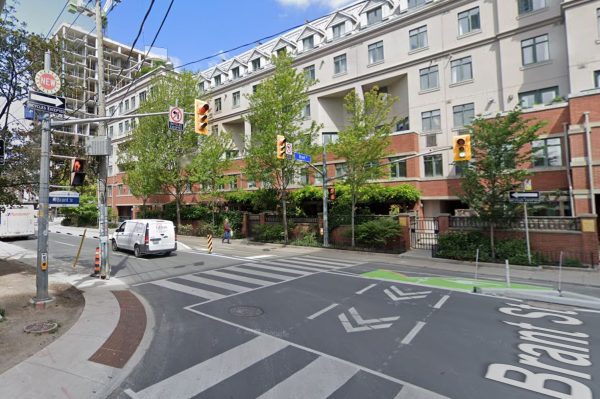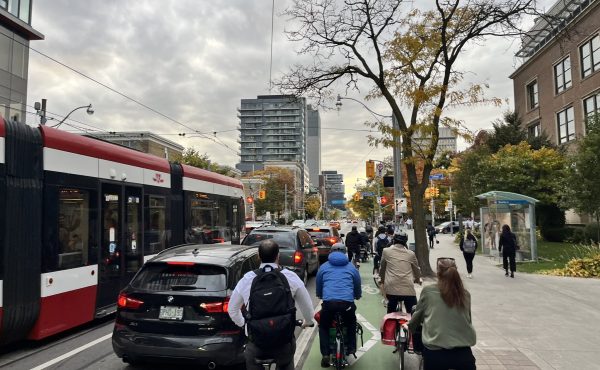In the early 2000s, I moved into a new condo building in the Garment District south-west of Queen and Spadina. The area had been mostly an employment area for decades, but thanks to the innovative “Kings” planning policy this somewhat deserted area was starting to host new mid-rise residences. To walk north to Queen West, Kensington Market, and other nearby destinations, we new residents had to cross at Brant and Richmond West, which had no traffic control. Although Richmond was one-way, so we only had to look in one direction, cars came barrelling along it around a curve at high speed. It was not safe at all.
We asked the City to install a traffic light. A traffic engineer came to a meeting and explained to us why it just wasn’t warranted. I can’t remember the details, but probably he said not enough people crossed there and it was too close to the traffic lights at Spadina.
Sometime later, a young woman was killed by a vehicle/driver while she was crossing Richmond at that intersection. Not long after that tragedy, a traffic light was installed.
I took to calling this the “Pedestrian Blood Sacrifice.” It so often seems to require that a pedestrian be killed or seriously injured, their blood spilled on the asphalt and flowers placed at a makeshift memorial altar nearby, in order to get a pedestrian safety measure installed. I’ve used this phrase before (PDF), but a recent development has brought it into focus again.
At this month’s City Council meeting, as part of a larger road safety item, Councillor Brad Bradford moved a motion:
to amend the Traffic Control Warrants used to evaluate the need for All-Way Stop Control, Pedestrian Crossovers and Traffic Control Signals so that the “Collision Hazard” warrant is satisfied if there has been at least one potentially preventable collision classified as a KSI (“Killed or Seriously Injured”).
To be clear, this is a good motion and I’m happy Councillor Bradford successfully got it passed.
The existing “warrant” system doesn’t make it automatic that an intersection will qualify for a safety review, let alone safety measures, if a pedestrian gets killed there. The warrants are the conditions required in order for staff to recommend installing traffic controls, and they often require a record of multiple collisions over several years, as well as a certain number of pedestrian crossings a day at a location that is, by definition (given there is no existing traffic control), dangerous.
Some recent cases illustrate this situation. Often these cases have happened in places where the local community had long been telling the City that it was dangerous for pedestrians – Gillian Kranias wrote about such a case here earlier this year. Meanwhile, this month Etobicoke and York Community Council had to pass a motion to ask staff to implement safety measures at Brown’s Line and Jellicoe after a young woman was killed by a driver there – it was not automatic.
So it’s good that, in the future, just one pedestrian death or serious injury will be enough to satisfy the collisions warrant (though that doesn’t guarantee changes – there are other warrant conditions as well).
At the same time, though, this motion is notable for literally codifying the pedestrian blood sacrifice. The path to overcoming the very restrictive traffic control warrants in places that the community might already have identified as dangerous for pedestrians is to have a pedestrian get killed or seriously injured at that location.
Pandering. Can we not get in front of this? Do the dead get the stuff named after them? The Jane Doe Memorial Crossing? Better to have the city step up, do the right thing, and keep Jane alive.
— Peter Burnside @peterburnside (@peterburnside) November 10, 2023
The other path is to have politicians overrule City staff, which does happen occasionally. But it requires a councillor to be both strongly committed to safety and to be able to convince their Community Council colleagues to overrule a recommendation made by staff.
Toronto has a “Vision Zero” road safety policy, which theoretically aims to eliminate road traffic deaths and serious injuries. Relying on pedestrians getting killed or injured in order to identify danger spots is hardly in keeping with this policy. We need to incorporate ways of listening to communities who know and experience their local dangers, find ways to evaluate those potential dangers in advance of a tragedy, and be willing to implement solutions before, not after, someone gets killed.






4 comments
How many other cities across Canada is this going on in?
All of them, I suspect.
I wholeheartedly agree. I’m not sure if traffic planners have the time and resources to actually study patterns except with their wheel counters. Those don’t count pedestrians. Tragedy seems to be the only call to action. However, it should also be said that lights might not always be the answer, a four way stop creates a different kind of traffic cadence that might bring additional safety and should not be ruled out. It all comes down to the specific conditions that unfortunately the traffic planners can’t keep up with.
On an off topic note, though, I have passed that intersections often and never really noted how unbelievably ugly the building you show is. Is that a cheap motel 8 or something? What an awful soul sucking structure. I mean, it doesn’t have to be heroic, but at least show some positive contribution to the community it pollutes. The developer or architect (if there even was one) should hang their head in shame.
I think safety measures are only a small part of the solution. Where we live at Mount Pleasant and Merton (just below Davisville), there have been non-stop accidents and a number of deaths; there is a seniors residence and a couple of schools within two blocks. “Safety measures” were put in; advance pedestrian lights, ripple strips, and plastic reflectors to create a little more space. It took about a week before drivers just started jumping the red when pedestrians cross… Drivers do this in front of the police, zero consequence. After about 2 days, all the reflectors got mowed down, so people just cut the corners full speed as before; there is no functional damager to their car, so they don’t care. It’s been a little better lately, but there was about a month back where about half the time I would go out, I would see a driver run a red. The law has no power with no enforcement. Safety measures don’t make anyone safer if all they do is creat a false sense of security; e.g. drivers jumping reds, or traffic islands getting run down. I don’t get why enforcement isn’t a thing; it would generate revenue and save lives, like is does in the UK, Australia, France, and just about every other first world nation.
Caronto/Carontop is a carservative/carist place, though they can be very helpful to kind of needed depending on what’s occurring in one’s life. The roads department is changing, as is the Council attitude, somewhat, and yet, as with the King St. ROW, maybe it’s the overall lack of enforcement that is the larger issue and could be more productive/cheaper to get. I think c. 90% of the police officers live out of TO; arguably that’s a real issue as there feels like a strong bias towards ‘like’ folk though there are both cyclists and pedestrians that are a ‘bit’ entitled/unaware of the terrorism of traffic, which can include cyclists and the more threatening/heavier e-bikes etc.
And stoplights aren’t good enough a ‘fix’ sometimes either: stoplights were added where Ms. Jenna Morrison was tragically taken at the base of Sterling Road and Dundas St. W. but the road/curve was left alone, and the pinch point – including the yellow centre line – stayed as is, with the City even repainting over the work of some activists who’d moved the centre line a bit. They will happily put in place $200K or more worth of equipment than dare to admit any liability in their diesign.